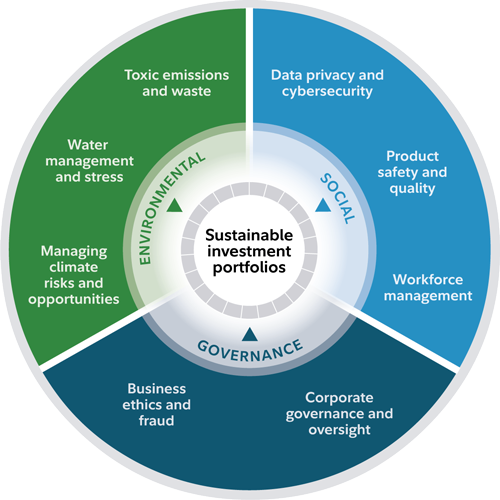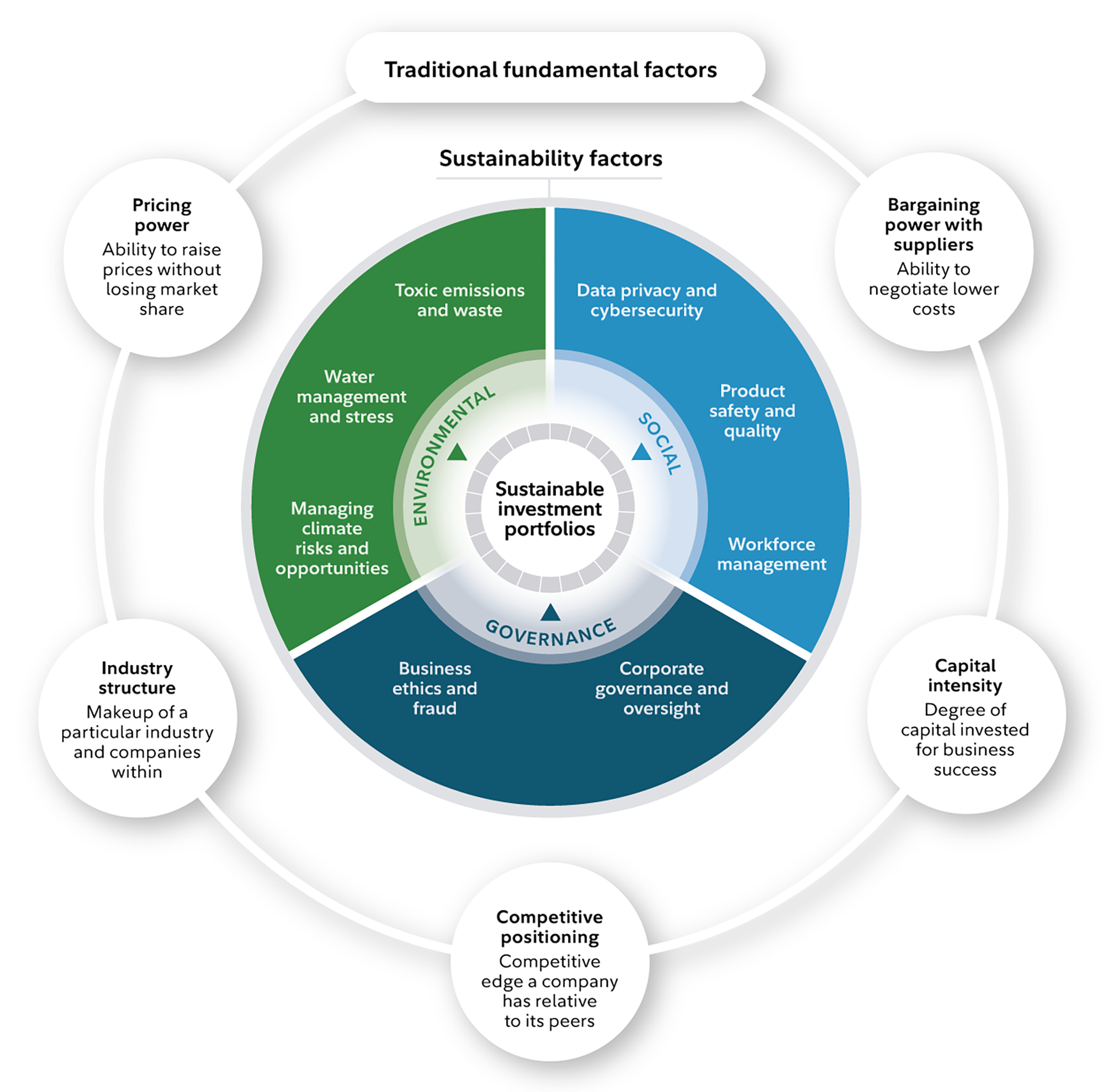What is sustainable investing?
Sustainable investing offers another way to evaluate companies. Our active sustainable investment portfolios focus on key factors that our research shows drive financial results. This includes assessing financially-material environmental, social, and governance factors.

Environmental
Evaluate how efficiently companies manage their environmental resources and the potential risks and opportunities this poses for long-term success.
Social
Assess how companies prioritize the well-being of their employees, suppliers, customers, and the communities in which they operate.
Governance
Examine how effectively companies manage their oversight structure, strategy, operations, and internal processes over the long term.

2024—2025 sustainable investing and stewardship update
Fidelity is committed to building our expertise in sustainable investment research and stewardship. We're excited to share our latest progress and priorities.
Learn more about sustainable investing

Water stocks: Time to take the plunge?
Learn how big dollars are flowing into water sustainability.

2023—2024 sustainable investing report
Discover how our core principles guided our 2023—24 sustainable investing and stewardship efforts.

Investing in ideas
Want to invest according to your personal beliefs and values? Thematic investing helps investors put their money where their beliefs are.
Fidelity offers multiple ways for you to invest sustainably
For sustainability-focused customers, Fidelity offers diverse funds backed by decades of research and investment expertise. Our active, broad-based sustainable investments seek out companies, issuers, or securities with strong environmental, social, and governance (ESG) profiles, while our thematic offering provides access to sustainability-linked investment trends.
Apply the below single-select filters to narrow down sustainable investment options
Fidelity® Sustainable Target Date Funds
Invests primarily in a diversified mix of sustainable assets that adjust over time based on an investor's target retirement date, providing a lifetime investment option in a single fund.
FAPHX
Fidelity® Healthy Future Fund
Fidelity® Healthy Future Fund
Invests in companies working to improve life expectancy, enhance people's lives, and decrease negative environmental impacts.
FCAEX
Fidelity® Climate Action Fund
Fidelity® Climate Action Fund
Invests in companies that are working to remove, reduce or mitigate the effects of climate change.
FFEBX
Fidelity® Environmental Bond Fund
Fidelity® Environmental Bond Fund
Invests in the debt of companies and projects that are recognizing, disclosing, and reducing environmental risk.
FWOMX
Fidelity® Women's Leadership Fund
Fidelity® Women's Leadership Fund
Invests in companies that prioritize and advance women’s leadership and development.
FLOWX
Fidelity® Water Sustainability Fund
Fidelity® Water Sustainability Fund
Invests in companies helping to deliver safe, reliable, and easily accessible water.
FSLEX
Fidelity® Environment & Alternative Energy Fund
Fidelity® Environment & Alternative Energy Fund
Focuses on alternative and renewable energy, energy efficiency, pollution control, water infrastructure, waste and recycling technologies, or other environmental support services.
FRNW
Fidelity® Clean Energy ETF
Fidelity® Clean Energy ETF
Invests in companies that distribute, produce or provide technology or equipment to support the production of energy from solar, wind, hydrogen, and other renewable resources.
FIAEX
Fidelity® Sustainable Core Plus Bond Fund
Fidelity® Sustainable Core Plus Bond Fund
Provides exposure to debt securities of all types believed to have positive ESG benefits.
FAPGX
Fidelity® Sustainable Low Duration Bond Fund
Fidelity® Sustainable Low Duration Bond Fund
Provides exposure to shorter maturity investment-grade debt securities believed to have positive ESG benefits.
FSIKX
Fidelity® Sustainable Intermediate Municipal Income Fund
Fidelity® Sustainable Intermediate Municipal Income Fund
Provides exposure to investment-grade municipal debt securities believed to have positive ESG benefits.
FSYRX
Fidelity® Sustainable International Equity Fund
Fidelity® Sustainable International Equity Fund
Provides exposure to developed market companies focused on robust ESG practices while seeking to maintain long-term growth.
FSYJX
Fidelity® Sustainable Emerging Markets Equity Fund
Fidelity® Sustainable Emerging Markets Equity Fund
Provides exposure to emerging market companies with an attractive ESG profile to provide value while minimizing risk.
FYMRX
Fidelity® Sustainable Multi-Asset Fund
Fidelity® Sustainable Multi-Asset Fund
Combines Fidelity’s expertise in asset allocation, stock selection and ESG integration to deliver an all-in-one diversified portfolio focused on long-term growth through exposure to sustainable securities.
FSEBX
Fidelity® Sustainable U.S. Equity Fund
Fidelity® Sustainable U.S. Equity Fund
Provides insight to current and future sustainable leaders through evaluating a company's ESG profile.
FITLX
Fidelity® U.S. Sustainability Index Fund
Fidelity® U.S. Sustainability Index Fund
Tracks a domestic stock benchmark that targets companies with high ESG ratings, while seeking to maintain broad market exposure.
FNDSX
Fidelity® Sustainability Bond Index Fund
Fidelity® Sustainability Bond Index Fund
Tracks a benchmark of investment-grade government, corporate, and asset-backed securities from issuers with strong sustainability profiles.
FNIDX
Fidelity® International Sustainability Index Fund
Fidelity® International Sustainability Index Fund
Tracks an international stock benchmark that targets companies with high ESG ratings, while seeking to maintain broad market exposure.
FSYD
Fidelity® Sustainable High Yield ETF
Fidelity® Sustainable High Yield ETF
An actively managed fixed income ETF that seeks to provide a high level of income through core exposure to high yield bonds with high ESG ratings.
Work with a Fidelity advisor
As a Fidelity® Wealth Management client, you can work with an advisor2 who can help to build a personalized plan around your full financial picture, and help to choose an investment solution designed to support your vision for the future.
Sustainable Personalized Portfolios account
Professionally managed multi-asset class portfolios with built-in, tax-smart strategies,3 seeking to maximize returns for a given level of risk while prioritizing sustainable investments.4
- Environmental
- Social
- Governance
Fidelity® Strategic Disciplines Environmental Focus Strategy
A separately managed account (SMA) that seeks to build a portfolio with reduced exposure to companies that have less favorable environmental ratings while approximating the risk characteristics and pre-tax returns of the Fidelity® U.S. Large Cap Index, while looking to boost after tax returns in taxable accounts.5
- Environmental
Digital investment management and advice
Once you work with Fidelity online to choose an investment strategy, you can explore our online planning resources to get clear next steps and track your progress.

Fidelity Managed FidFolios® Environmental Focus Strategy
A diversified portfolio of stocks that invests in some of the largest US companies while seeking to reduce environmental footprint and enhance after-tax returns through the use of tax-smart investing techniques.3, 5
- Environmental
No results match your selection. Try choosing fewer options.
How to get started investing sustainably

Open and fund your brokerage account

Research our sustainable funds

Choose a fund and select buy


